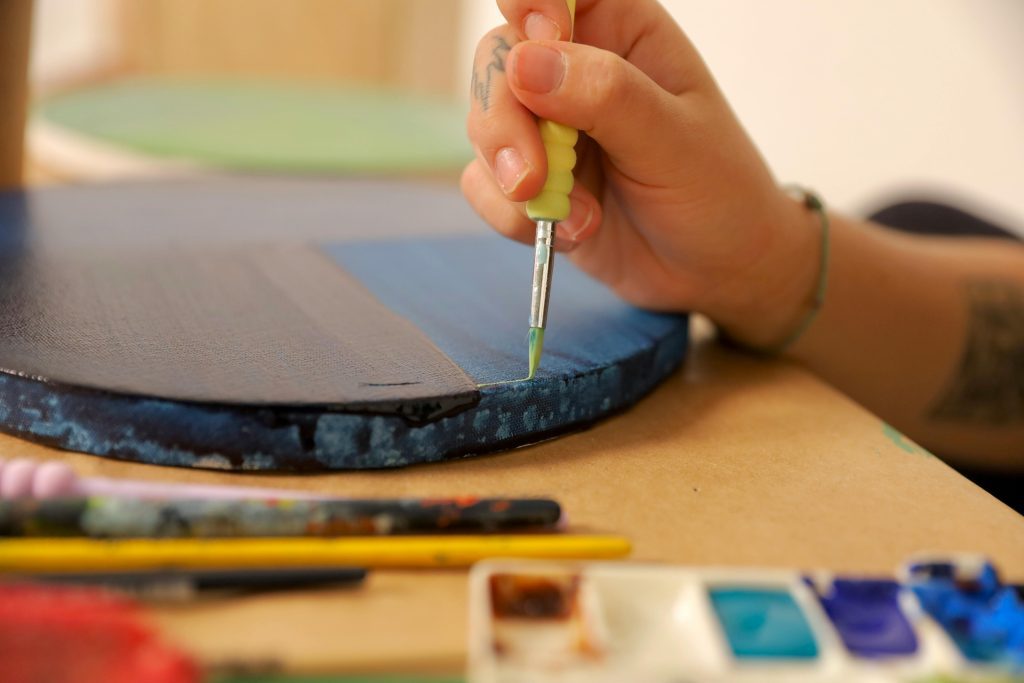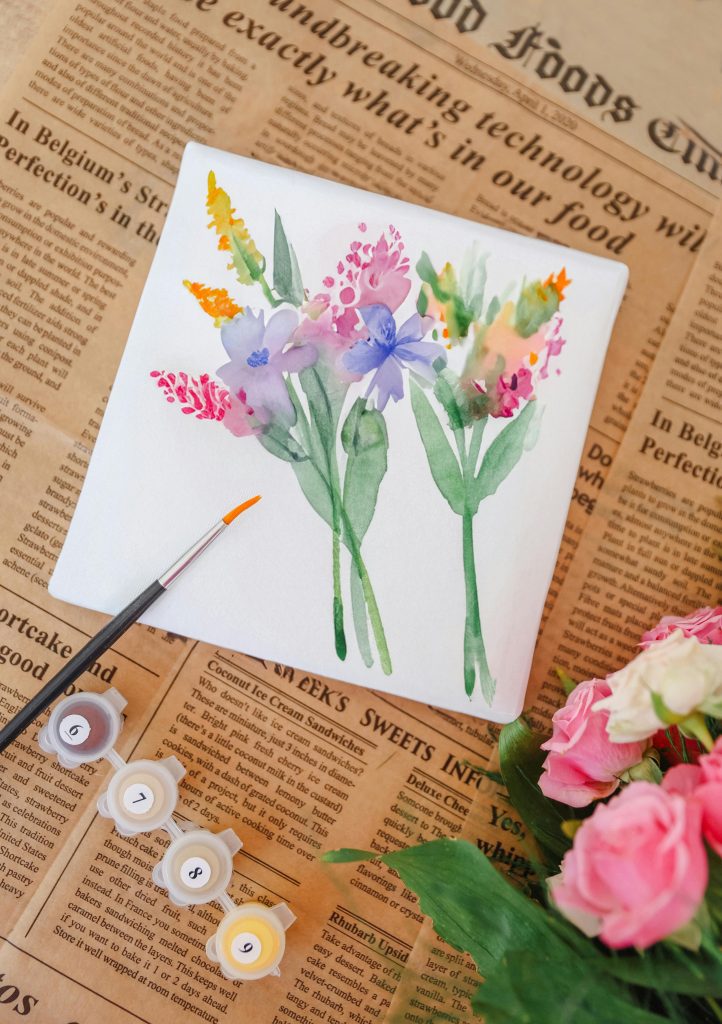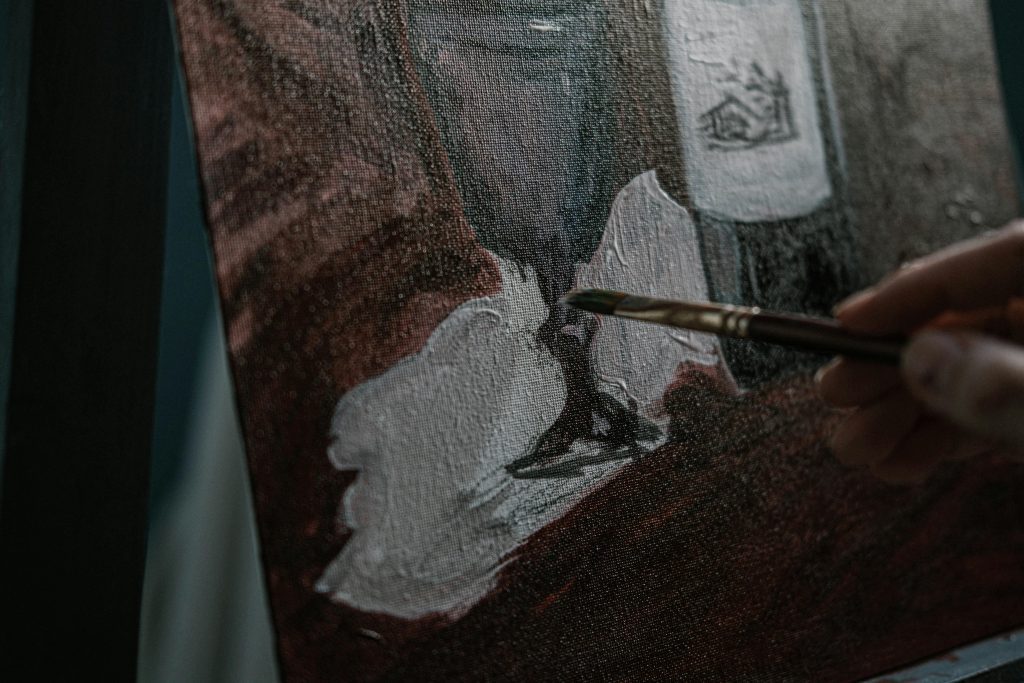How To Earn Passive Income From Your Art

Have you ever caught yourself daydreaming about earning money without constantly painting, drawing, or hustling exhibitions? You know, that fantasy where someone buys your art while you sip coffee in your PJs? Well, that dream isn’t as far-fetched as it sounds. Thanks to the digital age, artists like you can actually turn their skills into passive income, and yes, that includes selling digital downloads and tutorials.
Here’s the thing: passive doesn’t mean zero work. You still have to put in the time upfront to create something valuable, a digital print, a coloring page, a template, or even a step-by-step tutorial. But once it’s done, it can keep earning for you again and again, like a little money-making machine that never sleeps. And who wouldn’t want that, right?
Platforms like Etsy, Gumroad, Creative Market, and even your own website make it surprisingly easy to reach buyers across the globe. Suddenly, your art isn’t just hanging on your studio wall, it’s accessible to someone in New York, Tokyo, with just a few clicks. And the best part? You don’t have to ship physical products or chase payments every week.
And tutorials! Oh, the tutorials. Sharing your process, tips, or techniques online is not only helpful for other artists, but it also positions you as an expert in your field. Every time a new student purchases your course or download, it’s another stream of income flowing into your creative empire.
In this guide, we’re going to break down exactly how to get started. From what kind of digital products sell best to creating tutorials that people actually want to buy, we’ll cover all the insider tips you need to start building a sustainable income stream while still doing what you love most, making art.
So grab your sketchbook, your favorite coffee, and let’s talk about how you can finally have your art work for you, even when you’re not in the studio. Trust me, once you see the potential, you’ll be itching to start creating your first digital download.

So, What Exactly Counts as Passive Income Anyway?
Passive income sounds magical, right? Like money falling into your account while you take a nap. But for artists, it’s a bit more nuanced. Passive income doesn’t mean doing nothing; it means putting in work upfront that continues to generate revenue later, over and over. Think digital prints, downloadable templates, or even online tutorials. The initial creation is the hard part, but once it’s live online, it can keep paying off with minimal daily effort.
Let’s break it down. Imagine you create a set of digital art prints. You upload them to a platform like Etsy or Gumroad, set the price, and boom, people start buying them. You don’t need to package, ship, or meet anyone in person. That’s the beauty of it: your art keeps working for you while you sleep, paint, or brainstorm the next big project.
Tutorials work similarly. Record a process video or write a step-by-step guide, upload it, and suddenly students from around the world can learn from you at any time. Every new purchase becomes a little deposit in your passive income account. The best part? Once you’ve done the hard work of creating the content, it requires very little maintenance.
But don’t get me wrong, it’s not instant. The upfront effort can be substantial. High-quality files, clear instructions, and thoughtful presentation are key. Your audience has to feel like they’re getting something valuable, otherwise, they won’t pay. The better you set it up initially, the smoother the income stream flows.
Another crucial point: passive income works best as a portfolio of offerings, not just a single product. Think multiple prints, a few templates, and one or two tutorials. The more options you have, the more likely someone will find exactly what they need, and the more consistent your income becomes.
So, passive income is a combination of strategy, quality, and persistence. It’s not about doing nothing; it’s about setting up systems that allow your creativity to keep paying you back long after the initial work is done. And trust me, once you experience that first sale while you’re making coffee in your pajamas, you’ll be hooked.
Why Digital Downloads Are Your Best Friend Right Now
Digital downloads are basically magic for artists. They’re files you create once and sell repeatedly, whether prints, coloring pages, templates, or even digital stickers. The reason they’re amazing is simple: no shipping, no inventory, no messy logistics. You make it once, upload it, and it’s ready to sell around the world 24/7.
Imagine this: you create a series of abstract prints, package them as high-resolution JPEGs or PDFs, and suddenly someone halfway across the globe buys a copy. You didn’t ship anything, didn’t wait for a check in the mail, and didn’t spend hours on customer service. That’s the power of digital products: they scale effortlessly.
Platforms like Etsy, Creative Market, and Gumroad make it super easy to list your products and start selling. You don’t have to be tech-savvy or hire a web developer. A little time spent formatting your files and writing clear descriptions can open the door to a global audience, which is something a local gallery can’t match in reach.
The beauty is also in the variety. You could sell downloadable prints, templates for planners, coloring sheets, digital patterns, or even Photoshop brushes. If you’re creative enough, there’s a market for almost anything, and people are willing to pay for things that save them time, look beautiful, or teach them something.

Marketing is part of it, too. Social media, email lists, and blog posts can help people discover your digital products. But once a system is in place, your files continue selling even when you’re not actively promoting them every day. That’s the essence of passive income: front-loaded effort, long-term reward.
And let’s be honest, it feels amazing to know that your creativity can generate income repeatedly. Each download is a tiny validation that people value your work, and it’s one step closer to making your art career sustainable without burning yourself out on constant commissions or gigs.
Tutorials: Teaching What You Know Pays Off
Passive Income for Artists: Selling Digital Downloads and Tutorials
Have you ever taught someone a technique and felt that little spark of pride when they finally got it? Now imagine being paid for every person who learns from you, that’s tutorials as passive income. Whether video courses, PDFs, or even step-by-step guides, sharing your knowledge online can become a long-lasting revenue stream.
The key is creating valuable, clear, and engaging content. Nobody wants a tutorial that’s confusing or incomplete. Spend time making it understandable, visually appealing, and structured so students feel confident following along. A good tutorial is an investment that keeps paying dividends over time.
Platforms like Skillshare, Udemy, or even your own website allow you to host tutorials and reach a massive audience. The great part is that once it’s up, a single tutorial can earn money for months or even years, as long as it continues attracting students.
Consider starting small. A single technique-focused video or a simple PDF guide can be your first tutorial. Once you understand what your audience values and how they learn best, you can scale up to multi-part courses or bundle resources. Each addition increases your passive income potential.
Tutorials also help position you as an expert. When students buy your guide or course, they associate your name with authority in your field. This not only creates revenue but can also lead to future opportunities, like collaborations, commissions, or speaking gigs.
The best part? You’re doing what you love, sharing your art and skills, while also building a revenue stream that doesn’t depend on selling a physical object. Your knowledge becomes a product, and the more thoughtful and accessible it is, the more it keeps earning for you.
Pricing Your Digital Products Without Freaking Out
Pricing digital products can feel intimidating. You want it to be fair, appealing, and profitable, but how do you know what’s “right”? Start by thinking about value from the buyer’s perspective. How much would someone pay for a high-quality digital print or a tutorial that saves them hours of trial and error?
Look at similar products in your niche. On Etsy or Creative Market, see what other artists charge for similar items. This helps you find a sweet spot, competitive yet reflective of your skill and time. Undervaluing your work does more harm than good because it sets expectations too low.
Consider offering tiered pricing. For example, a simple downloadable print could be $5, a bundle of five $20, and an extended tutorial series $50. This gives your audience options and encourages larger purchases without scaring off beginners.
Don’t forget to account for platform fees and taxes. If a site takes 5–10% per sale, factor that in when deciding your price so you don’t end up underpaid. It’s part of thinking strategically about passive income, every cent counts when it’s your livelihood.
Remember: digital products are low-overhead, so even modest sales can add up quickly. Ten $10 downloads a week equals $500 a month without additional effort after the upload. Scale that with bundles, tutorials, or seasonal promotions, and the income can become meaningful.
Finally, trust yourself. You know your work’s value, and pricing it fairly yet confidently communicates that to your audience. Pricing is both a strategy and a statement: your art and knowledge are worth it.

Marketing Doesn’t Have to Feel Gross
When artists hear “marketing,” some of us shudder. But marketing digital products doesn’t mean being pushy; it’s about sharing your work with the right people. Think of it as a conversation rather than a sales pitch. Your audience wants to see your creativity, they just need a nudge to discover it.
Social media is your friend. Instagram, Pinterest, and TikTok are perfect for showing previews of your digital downloads or tutorials. Short clips, time-lapses, or before-and-after shots can create curiosity and drive sales. Don’t overthink it, just be authentic.
Email newsletters are gold. Collect emails from people interested in your work and send updates about new products, tips, or behind-the-scenes peeks. Unlike social media, you own this audience, and every message can lead to a direct sale.
Collaborate or cross-promote with other artists. If you’ve built relationships online or locally, featuring each other’s work in tutorials or bundles can expose your products to a wider audience without feeling pushy.
Optimize your listings. Clear descriptions, engaging visuals, and tags that match what buyers are searching for make your products easy to find. A great product won’t sell if no one sees it, so presentation matters as much as the content itself.
Finally, remember that marketing is part of the system. Done thoughtfully, it feels natural, and it ensures that the work you spent hours creating actually reaches the people who will value it, and pay for it, without making you feel like a salesperson.
Keeping the Money Rolling Without Losing Your Mind
So, your digital downloads and tutorials are up and running, yay! You’ve got that first little trickle of income, and it feels amazing. But here’s the thing: passive income isn’t literally hands-off forever. To keep the money rolling, you need to show your products a little love now and then. Think of it like tending a tiny, money-making garden. A bit of attention, and it keeps growing; neglect it, and things start to wilt.
First, set up a simple schedule. Maybe once a month, you release a new digital download, tweak a tutorial, or refresh your product images. You don’t need to overcommit, small, consistent updates keep your store active, which also helps it show up in search results and keeps your customers engaged. It’s the slow drip that adds up over time.
Don’t forget about customer interaction. Responding to questions, thanking people for purchases, or even sharing their creations if they use your products creates a sense of community. People love buying from someone approachable and genuine. Happy customers often return for more, and word-of-mouth is a passive marketing goldmine that doesn’t feel pushy.
Marketing in small doses is your friend. A quick Instagram story showing a new tutorial clip, or a short newsletter highlighting a bundle, keeps your audience aware without turning you into a full-time salesperson. You want visibility, not burnout. A little effort now means your products stay discoverable and relevant without eating into your creative time.
Also, revisit your older products occasionally. Maybe update a file for better quality, refresh a thumbnail, or tweak a description. These tiny tweaks can reignite sales and show that your portfolio is current, without requiring you to constantly make brand-new content. It’s efficiency at its finest: work smarter, not harder.
Finally, give yourself grace. Passive income should make your life easier, not more stressful. Celebrate small wins, track what’s working, and keep experimenting. The goal is a system that runs smoothly, gives you freedom, and continues rewarding your creativity, even while you’re off exploring new ideas, painting in your studio, or sipping coffee while checking that sweet “cha-ching” notification on your phone.
Bundles, Packages, and Why Bigger Feels Better
Bundles are like magic for your passive income. Instead of selling a single print or tutorial, why not create a package of three, five, or even ten? People love feeling like they’re getting extra value, and you earn more with almost the same amount of work. A bundle also encourages bigger purchases, which is an easy way to boost your revenue without creating entirely new products.

Start small, maybe a set of three coordinating digital prints, or a series of mini-tutorials that build on each other. Present them as a cohesive collection rather than random pieces thrown together. When your products feel curated and intentional, buyers perceive more value and are more likely to hit “Add to Cart.”
Bundles also give you flexibility in marketing. Highlight the savings in your listing or promotions. A “Buy 3 for the price of 2” offer instantly makes the purchase feel smart and irresistible. It’s the psychology of value in action, and it works beautifully in digital sales.
Another bonus: bundles can help you cross-promote your products. Someone might come for a single tutorial but end up exploring a full package once they see how well the pieces complement each other. You’re essentially increasing your average order value without extra work on new content creation.
If you’re feeling ambitious, create seasonal or themed bundles. Think holiday art prints, back-to-school templates, or beginner-friendly tutorials for new creatives. Limited-time bundles also create urgency, which can give your sales a nice little spike.
The takeaway? Bigger can feel better, but only when it’s thoughtful. Bundles, packages, and series allow your existing content to generate more income, reach more people, and keep your digital shop exciting for returning buyers.
Getting started with digital products and tutorials can feel overwhelming; there’s branding, social media posts, and even simple design decisions that can slow you down. That’s where the Artists Intro Pack comes in. This professionally designed Canva template bundle gives you everything you need to create a cohesive, polished presence online without spending hours figuring out layouts, fonts, or colors. From social media graphics to business cards, it’s all customizable, making it easy to focus on what you love most: creating art. By setting up your brand quickly and professionally, you can confidently start selling digital downloads and tutorials.
Creating Tutorials That People Actually Want to Buy
Not every tutorial will sell, and that’s okay. The trick is to focus on what your audience really needs. Pay attention to common questions, requests, or techniques your followers admire. Your tutorials should solve a problem or teach a skill people are eager to learn.
Think about your niche. Are you amazing at watercolour textures, digital illustration, or sculpting? Highlight your unique strengths. A well-targeted tutorial is more likely to attract buyers than a generic “how to draw” guide that’s lost in a sea of free YouTube content.
Presentation matters. Make sure your tutorials are clear, visually appealing, and easy to follow. Use step-by-step images or short video clips, and add helpful tips. The better your guide, the more value it provides, which translates directly into satisfied buyers and repeat sales.
Consider creating different levels of tutorials: beginner, intermediate, advanced. Some people are willing to pay a premium for advanced instruction, while beginners may want smaller, affordable guides. This tiered approach expands your market without requiring entirely new content.
Don’t underestimate the power of branding. Consistent thumbnails, clean layouts, and your signature style make your tutorials instantly recognisable. When people trust the quality of your content, they’re more likely to return and buy again.
Finally, gather feedback. Encourage students to leave reviews or share their results. This social proof can boost credibility and influence future buyers. Tutorials are not just about teaching; they’re about building a community that values your expertise.
Scaling Your Passive Income Without Losing Your Sanity
Once you have a few products, the real fun begins, scaling. Scaling doesn’t mean creating hundreds of new items at once; it’s about working smarter, not harder. Identify your bestsellers and find ways to expand them: bundles, complementary tutorials, or seasonal editions.
Automation is your friend. Schedule social media posts, set up auto-responses for common questions, and use platforms that handle delivery for you. This keeps your income flowing without requiring constant attention.
Consider diversifying platforms. Don’t rely on just one site. Different marketplaces attract different audiences, which increases your chances of sales and reduces risk if one platform changes its rules or fees.

Track what works. Which products sell the most? Which promotions generate clicks? Data helps you invest time wisely, focusing on what actually brings results rather than guessing or overworking.
Reinvest some earnings. Upgrade equipment for tutorials, create higher-quality prints, or invest in marketing tools. These small steps can significantly increase the return on your passive income over time.
Finally, pace yourself. Scaling should feel exciting, not overwhelming. Build your system in layers, celebrate small wins, and remember why you started: to make art while creating a life that supports your creativity.
Celebrate the Wins, Even the Tiny Ones
Passive income can feel slow at first, and it’s easy to get discouraged if you’re comparing yourself to others. But every sale, every new subscriber, every positive review is a win, and they add up. Celebrate them. Seriously.
Keep track of milestones. Maybe it’s your first tutorial sale, your 100th download, or your first bundle purchased by someone overseas. Each achievement proves your system works and motivates you to keep going.
Share your wins with your audience if it feels natural. People love seeing behind-the-scenes growth stories, and it can inspire confidence in your products. It also humanises your creative journey, making future buyers feel like they’re supporting a real person.
Reflect on what you’ve learned. Every launch teaches you something about your audience, your process, or your marketing. Use these insights to refine your products, create new offerings, and make smarter decisions moving forward.
Don’t forget the joy of creation. Passive income is impressive, but the heart of it is your art. Celebrate the freedom it brings: more time to experiment, more energy for passion projects, and less stress about bills.
And remember, every little bit counts. Even a single sale is proof that someone values your work enough to invest in it. Keep building, keep experimenting, and let your creativity continue paying you back for years to come.
